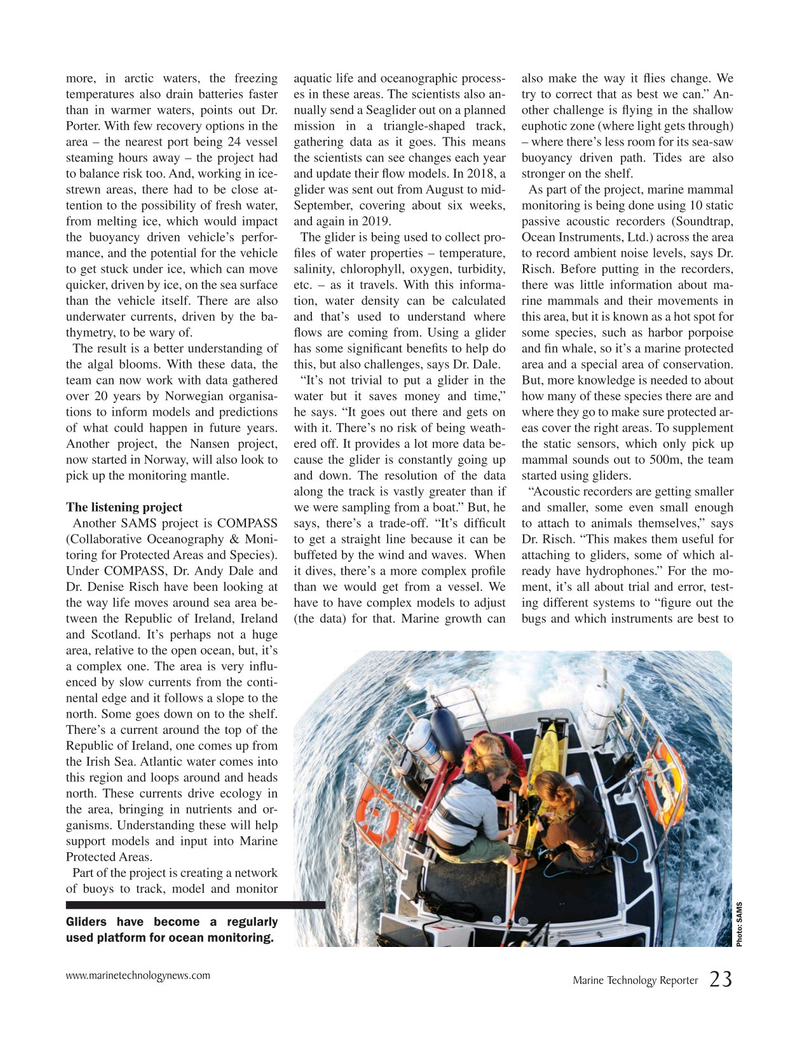
Page 23: of Marine Technology Magazine (January 2020)
Read this page in Pdf, Flash or Html5 edition of January 2020 Marine Technology Magazine
more, in arctic waters, the freezing aquatic life and oceanographic process- also make the way it ? ies change. We temperatures also drain batteries faster es in these areas. The scientists also an- try to correct that as best we can.” An- than in warmer waters, points out Dr. nually send a Seaglider out on a planned other challenge is ? ying in the shallow
Porter. With few recovery options in the mission in a triangle-shaped track, euphotic zone (where light gets through) area – the nearest port being 24 vessel gathering data as it goes. This means – where there’s less room for its sea-saw steaming hours away – the project had the scientists can see changes each year buoyancy driven path. Tides are also to balance risk too. And, working in ice- and update their ? ow models. In 2018, a stronger on the shelf. strewn areas, there had to be close at- glider was sent out from August to mid- As part of the project, marine mammal tention to the possibility of fresh water, September, covering about six weeks, monitoring is being done using 10 static from melting ice, which would impact and again in 2019. passive acoustic recorders (Soundtrap, the buoyancy driven vehicle’s perfor- The glider is being used to collect pro- Ocean Instruments, Ltd.) across the area mance, and the potential for the vehicle ? les of water properties – temperature, to record ambient noise levels, says Dr. to get stuck under ice, which can move salinity, chlorophyll, oxygen, turbidity, Risch. Before putting in the recorders, quicker, driven by ice, on the sea surface etc. – as it travels. With this informa- there was little information about ma- than the vehicle itself. There are also tion, water density can be calculated rine mammals and their movements in underwater currents, driven by the ba- and that’s used to understand where this area, but it is known as a hot spot for thymetry, to be wary of. ? ows are coming from. Using a glider some species, such as harbor porpoise
The result is a better understanding of has some signi? cant bene? ts to help do and ? n whale, so it’s a marine protected the algal blooms. With these data, the this, but also challenges, says Dr. Dale. area and a special area of conservation. team can now work with data gathered “It’s not trivial to put a glider in the But, more knowledge is needed to about over 20 years by Norwegian organisa- water but it saves money and time,” how many of these species there are and tions to inform models and predictions he says. “It goes out there and gets on where they go to make sure protected ar- of what could happen in future years. with it. There’s no risk of being weath- eas cover the right areas. To supplement
Another project, the Nansen project, ered off. It provides a lot more data be- the static sensors, which only pick up now started in Norway, will also look to cause the glider is constantly going up mammal sounds out to 500m, the team pick up the monitoring mantle. and down. The resolution of the data started using gliders. along the track is vastly greater than if “Acoustic recorders are getting smaller
The listening project we were sampling from a boat.” But, he and smaller, some even small enough
Another SAMS project is COMPASS says, there’s a trade-off. “It’s dif? cult to attach to animals themselves,” says (Collaborative Oceanography & Moni- to get a straight line because it can be Dr. Risch. “This makes them useful for toring for Protected Areas and Species). buffeted by the wind and waves. When attaching to gliders, some of which al-
Under COMPASS, Dr. Andy Dale and it dives, there’s a more complex pro? le ready have hydrophones.” For the mo-
Dr. Denise Risch have been looking at than we would get from a vessel. We ment, it’s all about trial and error, test- the way life moves around sea area be- have to have complex models to adjust ing different systems to “? gure out the tween the Republic of Ireland, Ireland (the data) for that. Marine growth can bugs and which instruments are best to and Scotland. It’s perhaps not a huge area, relative to the open ocean, but, it’s a complex one. The area is very in? u- enced by slow currents from the conti- nental edge and it follows a slope to the north. Some goes down on to the shelf.
There’s a current around the top of the
Republic of Ireland, one comes up from the Irish Sea. Atlantic water comes into this region and loops around and heads north. These currents drive ecology in the area, bringing in nutrients and or- ganisms. Understanding these will help support models and input into Marine
Protected Areas.
Part of the project is creating a network of buoys to track, model and monitor
Gliders have become a regularly used platform for ocean monitoring.
Photo: SAMS www.marinetechnologynews.com
Marine Technology Reporter 23
MTR #1 (18-33).indd 23 1/16/2020 11:23:01 AM

 22
22

 24
24
